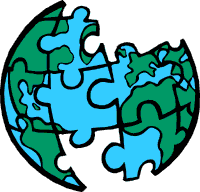Hands-on Activities: Puzzling Pictures
Grade Level 1-4
Essential Question What can scientists learn from images of planets remotely sensed during flybys?
Objective Students will learn how scientists use several small pieces of remotely sensed data to gather facts and make inferences about entire planets.
Materials jigsaw puzzle (for older students you may wish to use a 300-piece puzzle; for younger students you may prefer to use a puzzle that has fewer, larger pieces that are easier to manipulate), sealable sandwich bags, marker, paper, and pencils
 Approach Before class, complete a jigsaw puzzle out of the students' view. Working from left to right, carefully disassemble the completed puzzle. Remove one vertical strip at a time and place it in a sealable sandwich bag. Number each bag according to the order in which the puzzle pieces were removed from the completed puzzle. For example, the bag containing the first strip of pieces, which were removed from the far left end of the completed puzzle, should be numbered 1; the bag containing the next strip of pieces removed from the completed puzzle should be numbered 2; and so on. Approach Before class, complete a jigsaw puzzle out of the students' view. Working from left to right, carefully disassemble the completed puzzle. Remove one vertical strip at a time and place it in a sealable sandwich bag. Number each bag according to the order in which the puzzle pieces were removed from the completed puzzle. For example, the bag containing the first strip of pieces, which were removed from the far left end of the completed puzzle, should be numbered 1; the bag containing the next strip of pieces removed from the completed puzzle should be numbered 2; and so on.
Present the following to your students: A flyby is the flight of a spacecraft past a planet, moon, etc. The flight is close enough to remotely sense data. That means the spacecraft collects data about the surface of the planet, moon, etc. without actually touching it. This data is usually in the form of a picture. Pictures taken from satellites are called satellite images. Today, during its flyby mission, a satellite has gone out of control. The satellite has sent back some apparently random images of an unknown location. It is your job to analyze the information contained in these images to reach conclusions about the unknown location.
Divide the class into several groups of students. There should be no more than half as many groups as there are strips of puzzle pieces. Give a bag of puzzle pieces to each group. Tell them the puzzle pieces represent the data from the unknown location gathered during the flyby. Ask the students to work with others in their groups to assemble the pieces. They should try to determine what the entire completed picture looks like. Ask each group of students questions about what they see. Are there are any signs of plant life at the location? Are there any signs of intelligent life? What is the land like at the site? They should record their observations in two separate lists. One list should contain facts they have gathered from the images. The other list should contain inferences they have made from those facts. For example, if they see a house in the images, they should list that under "facts." Someone or something must have built the house. Therefore, they should list "signs of intelligent life" under "inferences." Ask them to draw a complete picture of the location based on what they have seen in the one strip of puzzle pieces.
Next, instruct them to look at the strips of puzzle pieces that other groups have assembled. They should consider the new facts and new inferences that can be made upon the collection of this new data. Ask the students to redraw the complete picture based on these new observations. When they have finished their drawings, show the puzzle box with the completed picture on it to the students. How do their drawings compare to the actual complete picture?
Reflection Ask the students what flybys have taught scientists about other planets. Have scientists ever made the wrong inferences from data collected from flybys? If so, how did they find out they were wrong. For example, scientists thought they saw canals on Mars. This would suggest some intelligent life form must have lived there and built the canals. Upon further investigation scientists discovered the canals were merely an optical illusion.
Guide the discussion to the point that students understand that a little information can tell us a lot. However, a lot of information can tell us more. Remote sensing is an important tool that scientists use to continually gather information about distant planets, stars, moons, etc.
Content for this activity provided by Dr. Jeanne Finstein. Illustration © 2003 www.clipart.com. |











